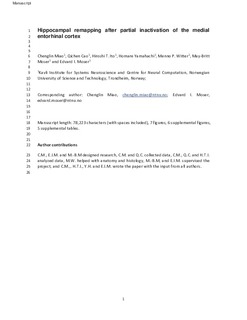| dc.contributor.author | Miao, Chenglin | |
| dc.contributor.author | Cao, Qichen | |
| dc.contributor.author | Ito, Hiroshi | |
| dc.contributor.author | Yamahachi, Homare | |
| dc.contributor.author | Witter, Menno | |
| dc.contributor.author | Moser, May-Britt | |
| dc.contributor.author | Moser, Edvard Ingjald | |
| dc.date.accessioned | 2018-01-05T09:22:38Z | |
| dc.date.available | 2018-01-05T09:22:38Z | |
| dc.date.created | 2016-02-24T18:35:01Z | |
| dc.date.issued | 2015 | |
| dc.identifier.citation | Neuron. 2015, 88 (3), 590-603. | nb_NO |
| dc.identifier.issn | 0896-6273 | |
| dc.identifier.uri | http://hdl.handle.net/11250/2475892 | |
| dc.description.abstract | Hippocampal place cells undergo remapping when the environment is changed. The mechanism of hippocampal remapping remains elusive but spatially modulated cells in the medial entorhinal cortex (MEC) have been identified as a possible contributor. Using pharmacogenetic and optogenetic approaches, we tested the role of MEC cells by examining in mice whether partial inactivation in MEC shifts hippocampal activity to a different subset of place cells with different receptive fields. The pharmacologically selective designer Gi-protein-coupled muscarinic receptor hM4D or the light-responsive microbial proton pump archaerhodopsin (ArchT) was expressed in MEC, and place cells were recorded after application of the inert ligand clozapine-N-oxide (CNO) or light at appropriate wavelengths. CNO or light caused partial inactivation of the MEC. The inactivation was followed by substantial remapping in the hippocampus, without disruption of the spatial firing properties of individual neurons. The results point to MEC input as an element of the mechanism for remapping in place cells. | nb_NO |
| dc.language.iso | eng | nb_NO |
| dc.publisher | Elsevier | nb_NO |
| dc.rights | Attribution-NonCommercial-NoDerivatives 4.0 Internasjonal | * |
| dc.rights.uri | http://creativecommons.org/licenses/by-nc-nd/4.0/deed.no | * |
| dc.title | Hippocampal Remapping after Partial Inactivation of the Medial Entorhinal Cortex | nb_NO |
| dc.type | Journal article | nb_NO |
| dc.type | Peer reviewed | nb_NO |
| dc.description.version | acceptedVersion | nb_NO |
| dc.source.pagenumber | 590-603 | nb_NO |
| dc.source.volume | 88 | nb_NO |
| dc.source.journal | Neuron | nb_NO |
| dc.source.issue | 3 | nb_NO |
| dc.identifier.doi | 10.1016/j.neuron.2015.09.051 | |
| dc.identifier.cristin | 1339889 | |
| dc.relation.project | Andre: the Louis Jeantet Prize, | nb_NO |
| dc.relation.project | Norges forskningsråd: grant number 145993 | nb_NO |
| dc.relation.project | EU/ENSEMBLE’’–grant agreement no. 268598; | nb_NO |
| dc.relation.project | Andre: Centre for Neural Computation, 223262 | nb_NO |
| dc.relation.project | Andre: the Ko¨rber Prize, | nb_NO |
| dc.relation.project | Andre: the Kavli Foundation | nb_NO |
| dc.relation.project | Norges forskningsråd: grant no. 214164 | nb_NO |
| dc.relation.project | EU/grant agreement 600725 | nb_NO |
| dc.description.localcode | Copyright © 2015 Elsevier Inc. All rights reserved. This is the authors' accepted and reviewed version of the manuscript for the article. This manuscript version is made available under the CC-BY-NC-ND 4.0 license http://creativecommons.org/licenses/by-nc-nd/4.0/ | nb_NO |
| cristin.unitcode | 194,65,60,0 | |
| cristin.unitname | Kavliinstitutt for nevrovitenskap | |
| cristin.ispublished | true | |
| cristin.fulltext | postprint | |
| cristin.qualitycode | 2 | |

